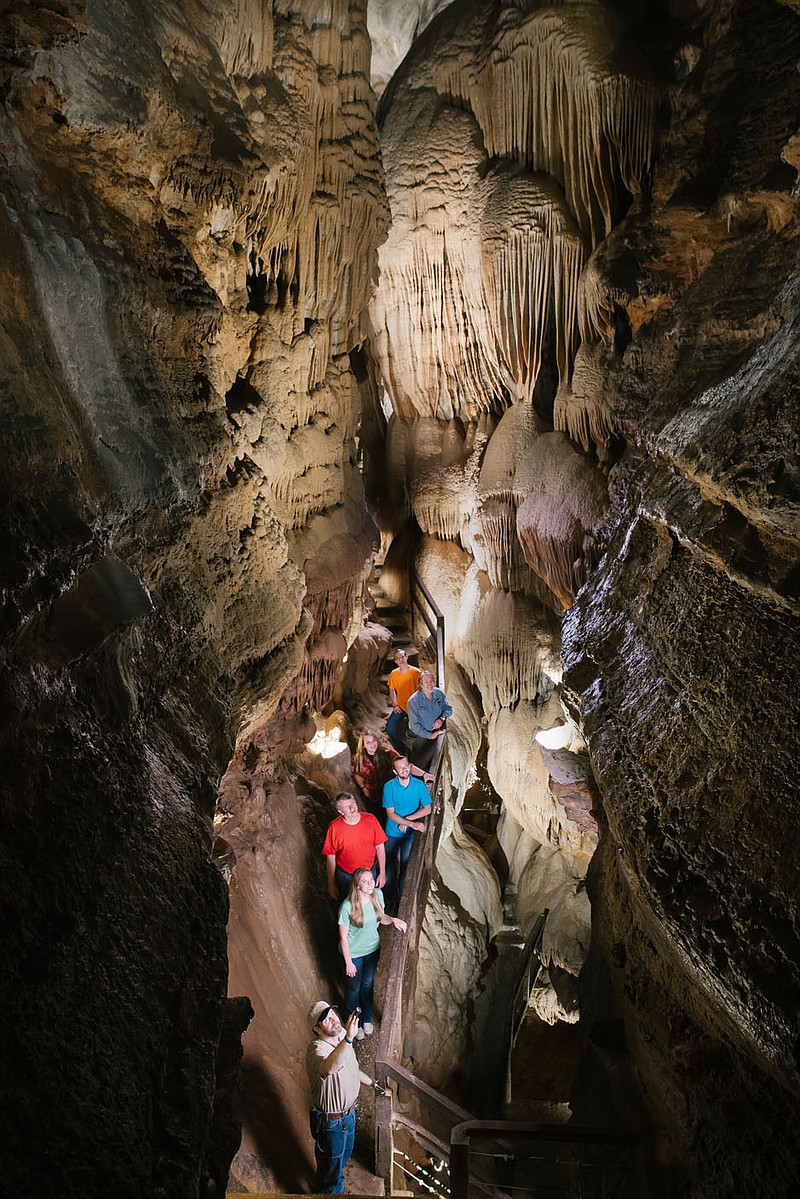Chris and Jody Gertson have been married nearly 30 years and have spent most of that time in a cave. Chris is operations manager, and Jody is a "manager who wears lots of hats" for the Branson attraction known as Talking Rocks Cavern.
As far as the Gertsons know, the cave was discovered in 1883 when a couple of teenage boys found it while hunting rabbits.
"The first documented account of anyone exploring the cave was in June of 1896, at the request of the landowners, the Irwin family," Chris Gertson says. "Truman Powell, his oldest son, William, and four others were lowered into the cave by means of a windlass. Truman was considered the local cave expert because of his education and scientific interest in caves and because of his desire to explore caves."
Gertson says there's no evidence Indigenous people used the cave -- previously known as "Fairy Cave" and "Fox Hunter Paradise Cave" -- because the entrance was tiny and concealed and led to a 100-foot drop. "Native Americans would have utilized more open, horizontal caves found in the Ozarks for shelter," he says.
Bats used to make their home in Talking Rocks Cavern, but they were displaced when the gift shop was built. That wasn't a problem for the bats, Gertson assures. "There are five species of bats utilizing other caves on the property. The caves and the bats that live in them are protected because bats are an important source of pest control."
The cavern -- 100 feet deep, 225 feet long and 40 feet wide at its widest point -- is home to microbial life, aquatic life such as crustaceans, five different species of salamander and the occasional pickerel frog, Gertson says, along with a host of insects that inhabit caves but are rarely seen, among them camel back crickets.
Guests see almost all of the cave that can be accessed by "able-bodied people, no matter their age."
"Talking Rocks Cavern is a vertical cave," Gertson explains. "Guests enter this cavern from the top and make their way down concrete stairs and pathways to a depth of 100 feet. Eight stops are made during the tour, giving the cave guide ample opportunity to share about the geology, cave life and history. [But] the 265 concrete steps in this cavern make it impossible for strollers and wheelchairs to maneuver.
"There are a few side passages that extend 40 to 50 feet, at which point they are clay filled or too small for a human to continue," he adds. "The big beautiful chamber that guests tour is a small portion of a larger drainage system that is much longer and deeper. Dye introduced into the water moving through the cave has been observed in a spring three quarters of a mile away and 200 feet lower than the floor of the chamber. There is certainly more cave, but we physically cannot get there."
What visitors can see includes many kinds of cave formations.
"The Cathedral is a canopy which is 90 feet tall and 50 feet in circumference, and guests are able to walk through it," Gertson says. "There is a column that is 65 feet tall, and this mineral deposit has a resemblance of an angel bowing its head, with wings spread out on either side. There are thousands of stalactites and stalagmites, impressive draperies, also known as cave bacon, and impressive flowstone."
Having emerged from the underground -- where it is always a temperate 62 degrees -- visitors can play a round of Cave Country Mini-Golf, go gemstone panning, crack a geode or interact on the new family games area. There are two SpeleoBox crawl mazes, a kids' playground, picnic areas and a nature trail with a 45-foot observation tower, all free to cave customers.
Gertson says some 38,000 people visit the cave in a typical year, and many ask if the cave was ever used by outlaws.
"The answer is that what makes Talking Rocks Cavern unique is that it is the only cave that Jesse James did NOT hide out in!"

More News
FAQ
Talking Rocks Cavern
WHEN — 9 a.m.-6 p.m. in June, July & August; 9 a.m.-5 p.m. daily the rest of the year
WHERE — 423 Fairy Cave Lane in Branson West
COST — $12.95-$21.95
INFO — 417-272-3366 or talkingrockscavern.…

